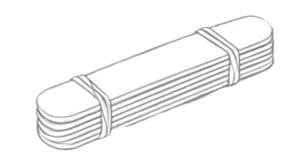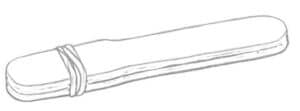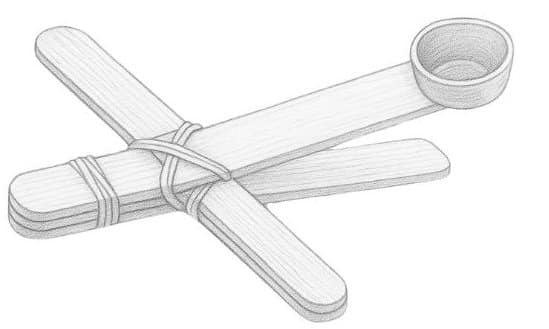
Craft Stick Catapult
Building a craft stick catapult is a great project for Scouts. It uses simple materials and easy steps. Scouts can make it in a short amount of time. It works well for meetings, camps, or STEM events.
This activity helps Scouts explore science in a hands-on way. They learn how stored energy can make things move. As they build and test their catapults, they also practice problem-solving. They get to see how small changes affect the results.
The catapult can fit into badge work for science or engineering. It also works well for teamwork. Scouts can work in pairs or small groups. They can test different designs and compare results.
This project is also a safe way to teach basic tool use. Scouts use rubber bands and glue, and they need to follow safety rules. It gives them a fun, clear goal. When they see the catapult work, it builds confidence and sparks curiosity.
From Castles to Craft Time:
Long ago, real catapults were used in battles. Soldiers used them to launch rocks at castle walls. These machines were big, heavy, and made from wood and rope. They worked by storing energy in twisted ropes or bent wood. When released, the energy would launch the object through the air.
Today, we don’t need to knock down castles. But the idea of a catapult still catches our attention. Smaller versions are now used to teach science. Kids build them to learn about motion, energy, and force. Craft stick catapults are a simple way to explore these ideas.
Teachers and Scout leaders started using craft stick catapults in the classroom and in programs. They’re easy to build, cheap, and safe. Scouts can try them out indoors or outdoors. Over time, this small project became a favorite in STEM lessons, Scout meetings, and rainy-day activities.
Now, building a craft stick catapult is part tradition and part challenge. Every group seems to have its own way of making one. Some use spoons, others use straws or paper clips. But the basic idea stays the same—make something fly and have fun learning while doing it.
What Scouts Learn When Things Go Flying
Den leaders, this is a great hands-on project that helps your Scouts learn while having fun. When they build a craft stick catapult, they are doing more than just building something. They are using science and thinking skills without even knowing it.
First, they learn about energy. When they press down on the catapult, they store energy. When they let go, the energy is released, and the object flies. This is a simple way to show how stored energy becomes motion. It makes big science ideas easy to understand.
Second, they practice testing and changing things. If their catapult doesn’t work right, they try something new. Maybe they move the rubber bands. Maybe they change how many craft sticks they use. This helps them learn how to solve problems and not give up.
Third, they work together. Scouts can help each other, share ideas, and take turns launching. This helps with teamwork and communication. You will see them talk, laugh, and figure things out as a group. It’s a great way to build confidence and cooperation in your den.
Craft Stick Catapult Instructions
Materials Needed:

- 2 tongue depressors (or large craft sticks)
- 7 regular craft sticks
- 7 rubber bands
- 1 plastic bottle cap
- Hot glue gun (and glue stick)
- Safety glasses (optional but a good idea)
- Small marshmallows or erasers for ammo
Instructions:

- Stack the 7 regular craft sticks on top of each other.
- Wrap one rubber band around each end of the stack to hold them tightly together.
- Take the 2 tongue depressors and rubber band them together on one end only.
- Slide the stack of 7 sticks between the open end of the tongue depressors.
- Now, wrap a rubber band diagonally across the spot where the tongue depressors cross over the stack. Wrap it several times.
- Wrap a second rubber band diagonally the other way. This helps hold the stack in place.
- Use the hot glue gun to attach the bottle cap to the end of the top tongue depressor. Let it dry fully before using.
- Put on safety glasses. Place a soft item like a marshmallow in the cap, press down, and let go to launch.
Safety Tips:

- Only aim the catapult in a safe direction.
- Never point it at people or animals.
- Use safety glasses to protect eyes.
- Have an adult help with the hot glue gun.
Variations:
- Try changing the number of sticks in the center to see what happens.
- Use different types of rubber bands to test the results.
- Try a plastic spoon instead of a bottle cap for a different launcher style.
- Hold a distance contest to see which Scout can make theirs go the farthest!
More Resources

Projects for Scouts
If your Scouts had fun building the Craft Stick Catapult, they might enjoy some other hands-on projects too. My website has a page full of ideas that are great for meetings, rainy days, or just learning something new in a fun way.
You’ll find lots of easy projects using simple materials. These are perfect for younger Scouts and don’t take much time to set up. Visit my page to see the full list of Projects for Scouts and get inspired for your next activity.
Frequently Asked Questions for the Craft Stick Catapult
What age group is this project best for?
This project works well for Cub Scouts and younger Scouts BSA. Younger Scouts may need some help with the rubber bands and glue.
What can we use for ammo?
Small marshmallows, pom-poms, or pencil erasers work well. Do not use anything sharp or heavy.
Can we use regular craft sticks instead of tongue depressors?
Yes, but tongue depressors are stronger. Regular sticks might not work as well for the throwing arm.
Is it safe?
Yes, if used the right way. Always aim away from people and wear safety glasses if possible.
What should we do if the catapult doesn’t work well?
Try moving the rubber bands or changing how many sticks are in the stack. Small changes can help a lot.
Do we need a hot glue gun?
You can use strong glue, but hot glue dries faster. Have an adult help if you use hot glue.
Launch It Like You Mean It
The Craft Stick Catapult is a fun and easy STEM project for Scouts. It uses simple items like craft sticks, rubber bands, and a bottle cap. You can build it in just a few minutes. Scouts enjoy testing how far their catapults can launch small objects.
This activity teaches about energy, motion, and force. It also builds problem-solving skills. Scouts learn by trying different setups and seeing what works best. They can change how many sticks they use or where they place the rubber bands.
It’s also a good team project. Scouts can build in pairs and compare results. It’s safe when used with soft items like marshmallows. And it gives Scouts a clear goal with a fun outcome.
This catapult fits well into many Scouting programs. It works for STEM badges, teamwork goals, or just something active to do at a meeting. It’s simple, cheap, and keeps Scouts engaged.



Leave a Reply